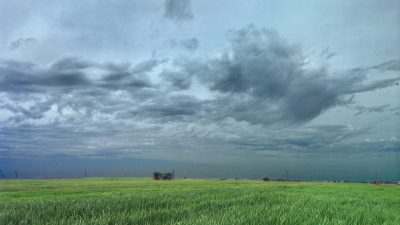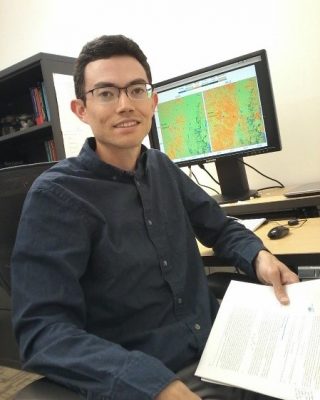Ian Williams is among many national laboratory scientists developing new ways to integrate land-atmosphere interactions into climate-predictive models.

Ian N. Williams is a research scientist at the Lawrence Berkeley National Laboratory (LBNL), where he is principal investigator in a program called Land-Atmosphere Coupling and Convection in the Water Cycle.
More broadly, his research involves many threads within the world of atmospheric science. Among first-author publications by Williams are studies of solar radiation and winter wheat, polar vortex events, and tropical convection and clouds—a recurring interest since wrapping up his dissertation on that topic at the University of Chicago (PhD, 2012).
Lately, however, Williams spends a lot of his time on the land-atmosphere interactions project, which is sponsored by Atmospheric System Research (ASR), a U.S. Department of Energy program. (On the LBNL website, his ASR project is combined with another on radiative forcing.)
Land-atmosphere interactions was previously led by senior scientist Margaret Torn, with whom Williams and seven other researchers work in Torn’s Biosphere-Atmosphere program domain. That’s an arm of LBNL’s Climate and Ecosystem Sciences Division. In addition to ASR research, it touches on climate modeling and terrestrial ecosystem science.
Among other pursuits, Williams and his project team are working on ways to improve predictive earth system models by sharpening representations of the way land processes (including carbon, water, and energy cycles) link to clouds, radiation and precipitation.
“The land surfaces have influences on climate that we have to get right,” he says.
Leaf Area Index
In part, getting those influences right requires getting into the weeds—literally. That is, understanding the role of vegetation in land-atmosphere interactions—or, more generally, its role in the water cycle.
Previously, it was thought that soil moisture was the main driver of variations in evaporative fraction, a ratio that measures how energy is “partitioned” over land surfaces between latent and sensible heat. It can be used to infer daily energy balance, an important parameter in climate models.
Williams once gave a talk titled “Putting the Land Back in Land-Atmosphere Interactions,” the point being, he says, “that without considering vegetation you’re not really getting at the interactions.”

In a 2015 paper that Williams calls “foundational,” he and Torn argue for a new metric that pivots mostly on the leaf area index (LAI) and the uptake of carbon dioxide instead of soil moisture as a correlate of the evaporative fraction.
LAI is used to quantify plant canopy. It is also useful in predicting evapotranspiration, which affects the energy balance of the land’s surface.
“We revisited what controls surface heat flux,” said Williams of the paper, and found “that it is affected by more things than soil moisture,” including transpiration and photosynthesis.
Williams was also lead author on a 2016 follow-on paper with Torn and others. They tested the LAI idea in a version of the National Center for Atmospheric Research’s Community Earth System Model and showed that better representing vegetation improved the model’s predictive acuity with regard to temperature and precipitation.
Improvements in land surface models, they concluded, can improve the prediction of climate extremes.
“Models are too tightly constrained by soil moisture” alone, says Williams, “which has impacts on climate prediction.”
For one, he says, if evaporation of moisture from the surface is “erroneously low, that can lead to prediction bias, (including) temperatures that are too warm.”
The next related Williams-Torn paper, now in review, looks more specifically at the impacts of this new model scheme on predictions of convective clouds and precipitation on seasonal scales.
Interpreting Carbon Fluxes

Williams was still in graduate school when over two summers (2006 and 2009), he worked at LBNL as a research assistant. Torn was there, along with two other scientists who would be future co-authors: terrestrial ecosystems expert William Riley and Sebastien Biraud, whose specialty is observing and measuring atmospheric trace gases.
“That’s where I really learned about the carbon cycle and about putting photosynthesis into earth system models,” he says. “I was fortunate to have that exposure early on.”
Williams returned as a postdoctoral scholar (2012-2016) after his PhD work on tropical convection. But he brought something else with him from the Department of Geophysical Sciences at the University of Chicago: an appreciation for interdisciplinary work.
His dissertation advisor, Raymond Pierrehumbert, now a professor of physics at the University of Oxford, “taught me the importance of thinking about climate as a coupled system,” says Williams, “and how wrong you can be if you don’t take a systems approach and instead look at one component insolation. It’s this systems perspective that gives interdisciplinary work its importance to me.”
While Williams took in that lesson as a PhD student, he also cultivated an interest in problems in geology and paleoclimate.
“You can’t separate geology from biology on these time scales,” he says, “and that was always on my mind there—the importance of biology.”
Land-Surface Models, Anew
That broad intellectual experience during PhD studies set Williams up very well—not only for the issues he was introduced to at LBNL (interpreting trace gases and carbon fluxes)—but also for a transition to what he calls “the third generation of land-surface models.”
That transition began around 2005, says Williams. “It was the first time plants had been included in climate models in a mechanistic way, accounting for coupled carbon and water cycles,” thanks to the pioneering work of Joseph Berry, an expert in biosphere-atmosphere interactions now at the Carnegie Institution for Science. (Williams interacted with him during his first summer at Torn’s lab in 2005.)
Even today, he adds, “these kinds of models are pretty new. We have not explored all the uncertainties and consequences for climate.”
Still, it is impossible to separate climate from the carbon cycle on decadal scales.
“It’s a necessary perspective,” says Williams—an acknowledgment, for one, that over time forests can collapse into grasslands, “which would have a first-order effect on the water cycle. Atmospheric models we are developing have to be robust to those changes. We can’t just tune the models for today’s land surface.”
It’s important work.
“The simple fact is that the climate is affected by the land surface because of fluxes of water and energy at the land-atmosphere interface,” says Williams—in an interplay of soil moisture, plant types, and the height of the plant canopy, which can be inches to hundreds of feet.
All these interactions are also part of the convective cloud parameterization problem.
“Convection is the result of a sequence, a chain of processes,” he says. “It’s important to get each link in this chain right.”
Watching the Weather
Around the time he started high school, Williams and his family moved from suburban Philadelphia (where he experienced the epic Blizzard of 1993) to suburban Kansas City, Kansas, “where only a few months after we got there, the tornado sirens went off. The weather was really different.”
When the first storm cell was going over his town, Williams took shelter in a basement room where he watched the drama unfold on an old black-and-white TV. “I still remember what the radar echo looked like,” he says.
People in Kansas know the weather, care about it, watch for it, and know the lingo, he says. “Low-level jets, convective systems. People are pretty knowledgeable.”
Soon Williams was too. At age 15 he was tracking National Weather Service data and reading online technical forecast discussions and poring through textbooks to search terms he did not know.
By his sophomore year, Williams was downloading numerical weather data, scanning seasonal weather forecasts, and investigating, in an El Niño year, the effects of ocean surface temperatures on climate.
“I became interested in science more generally through my interest in atmospheric science,” he says of his high school years. “After that, I took physics more seriously. I took math more seriously.”
Williams, a pianist, started college at the University of Kansas to study music. But later, drawn to study atmospheric science, he transferred to Cornell University (B.S. 2005, M.S. 2007).
“The passion for understanding the weather and climate was just something I kept coming back to,” he says.
‘Embracing the complexity’
At the University of Chicago, Williams covered a lot of ground—and sea—in his doctoral research. He looked at two issues: the cloud radiative effect of convective clouds in the tropics (“a huge concern for climate projection,” he says) and the coupling between the ocean surface and the Earth’s energy balance.
Today at LBNL, the near future involves “embracing the complexity,” says Williams. That includes combining observational data with high-resolution atmospheric models that are coupled to land surface models—all to investigate the interaction with clouds “in an experimental way,” he says.
Is there life for him outside of science?
Sometimes, says Williams. He enjoys taking day hikes with his wife and—lately—reading about other scientists, including Nobel laureate Ernest O. Lawrence, the founder of LBNL.
One book launched what he calls “my current reading program”: the 2007 story of dendrochronologist Edmund Schulman, who developed climate records from ancient bristlecone pines. (Some are well over 4,000 years old.)
His latest foray into print was “The Brothers Vonnegut: Science and Fiction in the House of Magic,” a dual biography of cloud scientist Bernard Vonnegut and novelist Kurt Vonnegut Jr.
“It’s interesting, reading their stories,” says Williams of fellow scientists. “Some of it I can relate to—the difficulties of a science career and how they found their way.”
# # #
This work was supported by the U.S. Department of Energy’s Office of Science, Office of Biological and Environmental Research as part of the Atmospheric System Research Program.

